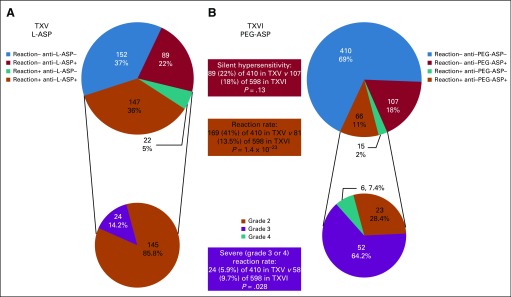FIG 1.
Reactions by antibody status, preparation, and protocol. (A) Frequency of patients by their anti–Escherichia coli asparaginase (L-ASP) status and reaction to L-ASP in the Total XV study (TXV; upper chart). Distribution of patients who experienced reactions to L-ASP by their reaction grade (lower chart). (B) Frequency of patients by their anti-pegaspargase (PEG-ASP) status and reaction to PEG-ASP in Total XVI study (TXVI; upper chart). Distribution of patients who experienced reactions to PEG-ASP by their reaction grade (lower chart). All reactions are grade 2 or greater. Silent hypersensitivity (antibody positive but reaction negative) occurred in 89 (22%) of 410 and 107 (18%) of 598 patients on TXV versus TXVI (P = .13). Grade 2 to 4 reactions were less common (81 [13.5%] of 598 patients) in TXVI (to PEG-ASP) than in TXV (169 [41%] of 410 patients; to L-ASP; P = 1.4 × 10−23), but a higher proportion were grade 3 or 4 (24 [14.2%] of 169 v 58 [71.6%] of 81; P = 1.5 × 10−19). Overall, there were more grade 3 or 4 reactions with PEG-ASP than L-ASP (P = .028). All P values were generated from χ2 test. Reaction+, patients with allergic reactions to L-ASP (TXV) or PEG-ASP (TXVI); Reaction−, patients who received L-ASP (TXV) or PEG-ASP (TXVI) but did not have reactions to asparaginase.

